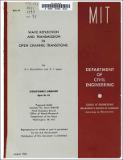Wave Reflection and Transmission in Open Channel Transitions
Author(s)
Bourodimos, E. L.; Ippen, A. T.
Download04293357.pdf (8.829Mb)
Metadata
Show full item recordAbstract
The topics of this report are a theoretical development and an experimental investigation of the transformation of water-wave characteristics in the reflection and transmission processes through channel transitions of varying geometry, connecting two prismatic channels of constant cross section. The theoretical developments are based on small amplitude linearized wave theory in an inviscid, homogeneous and incompressible fluid. Two theoretical aspects have been treated: 1. The wave amplitude variation in a channel of constant width for a bottom of arbitrary configuration was obtained for the various characteristics of the oncoming waves. The basis of this development is the energy transmission undiminished by reflection or friction. The general expression of the integral type was solved for two limiting cases: for shallow water waves resulting in Green's law and for the range from deep water to intermediate depth water waves resulting in an exponential formula. 2. Reflection and transmission coefficients were derived for shallow water waves for gradual channel transitions, specifically for four cases: A - for linearly varying depth and constant width B - for linearly varying depth and width C - for linearly varying width and constant depth D - for parabolic variation of depth and constant width A numerical evaluation of the theoretical expressions for reflection and transmission coefficients shows essentially fair agreement with the experimental findings for shallow water waves. The experimental part of the report is concerned with the determinations of reflection and transmission coefficients and of the energy relations including dissipation for the above cases A, B, and C. The experimental range of wave conditions extended from deep water to shallow water waves. The results are compared to previous investigations and to the conventional classical theories, as the theoretical derivations above are restricted to shallow water waves. Relations were also found with regard to wave steepness, a factor which cannot be theoretically dealt with so far in channel transitions. Reflection and transmission coefficients show considerable dependence on wave steepness, the decrease being most pronounced for the former. Reflection coefficients are generally higher than those predicted by Lamb's theory for abrupt transitions. Transmission coefficients therefore are exhibiting the opposite trend.
Description
Prepared under contract with the Fluid Dynamics Branch, Office of Naval Research no. Nonr-1841(59)
Date issued
1966-08Publisher
Cambridge, Mass. : Hydrodynamics Laboratory, Dept. of Civil Engineering, Massachusetts Institute of Technology
Other identifiers
98
Series/Report no.
R (Massachusetts Institute of Technology. Department of Civil Engineering) ; 66-34.Report (Massachusetts Institute of Technology. Hydrodynamics Laboratory) ; no. 98.